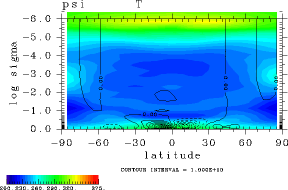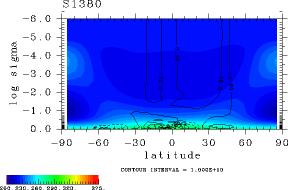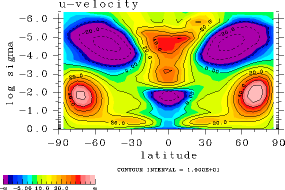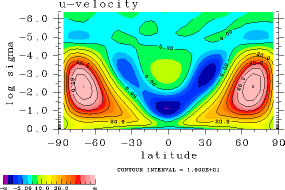b. Equilibrium State: Meridional Structure of the Upper Layer
Figure 1(a) is prepared to examine the meridional temperature
distribution and circulation in the upper layer. In this figure,
log10σ is adopted for the vertical
coordinate. The temperature distribution shows that temperature
becomes almost constant in the region located between the tropopause
and σ= 10-5 level. However, above this
region, temperature increases with the altitude. When the vertical
filtering and seven damping layers are implemented (Figure 1(b) ,
the high-temperature region does not appear. Therefore, the cause of
the formation of the upper-layer high-temperature region may be
associated with wave activity. However, neither an analysis nor a
control experiment has yet been conducted to identify the
cause. Such an analysis and control experiment will be addressed in
future research.
(a)  |
(b)  |
|
Figure 1: Meridional distributions of temperature (K) and mass stream function (kg/sec). (a) Without filtering and with a single damping layer. (b) Experiment S1380 (filtering included in all layers, seven damping layers).
|
Regarding zonal wind, the presence of the subtropical jets
(latitude: 30°, height: approximately logσ =
-0.5) and the polar night jets (latitude: 70°, height:
approximately logσ = -2.0) are evident Figure 2(a)
. When filtering is implemented, the subtropical jet and the polar
night jet merge, making it difficult to examine the two separately,
as shown in Figure 2(b) . Furthermore, the polar night jets take
forms that have the appearance of being crushed from the top, and
the jet axes are shifted to lower altitudes and latitudes than in
the case with no filtering applied.
(a)  |
(b)  |
|
Figure 2: Meridional distributions of zonal wind
(m/sec). (a) Without filtering and with a single damping layer. (b)
Experiment S1380 (filtering included in all layers, seven damping
layers). |



